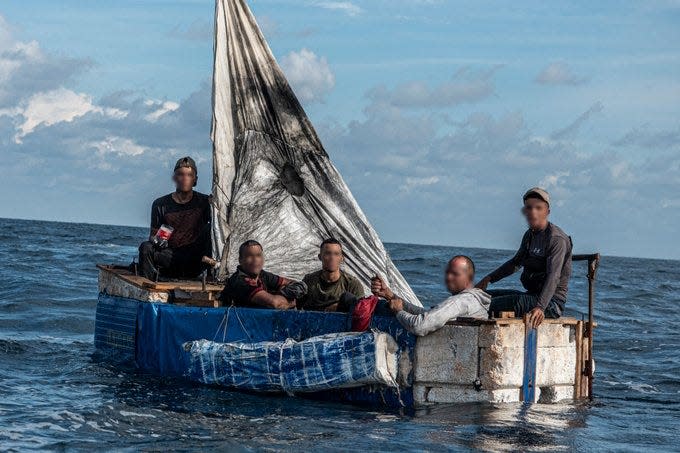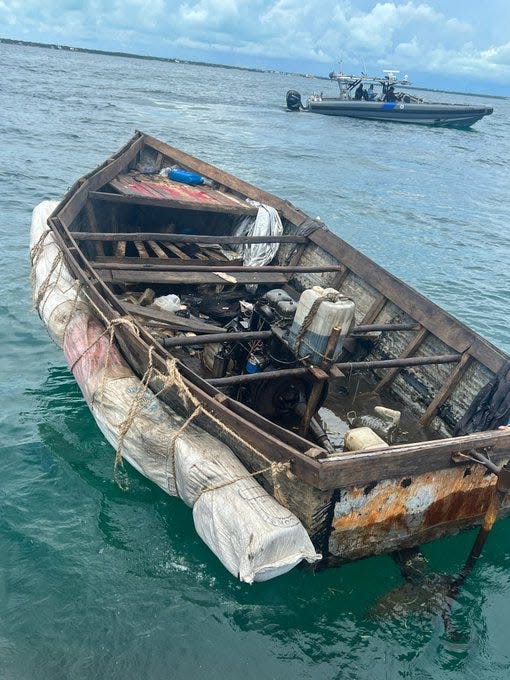Cubans, Haitians are fleeing to US in historic numbers. These crises are fueling migration.
Some float across miles of open ocean on chunks of Styrofoam fastened together with bamboo twine. Others dodge Mexican cartels and wade across the Rio Grande with smugglers on the U.S.-Mexico border.
By land and by sea, more than 230,000 Cuban and Haitian migrants have tried to reach the United States this year to seek asylum, marking one of the biggest migrations to the United States either nation has witnessed.
U.S. Border Patrol agents encountered more than 175,000 Cubans at the Southwest border this fiscal year through July -- a bigger Cuban exodus than the Mariel boatlift, which saw 125,000 Cubans flock to South Florida shores on boats over six months in 1980.

In the same time period, border agents encountered 42,230 Haitians, on pace to surpass the 47,255 encountered last year.
By sea, the numbers are equally stark. Through Tuesday, the U.S. Coast Guard had stopped 5,545 Cubans in open water – higher than the total number (5,396) intercepted in 2016, the final year before the Obama administration ended a policy allowing Cubans who reached U.S. soil to stay, according to Coast Guard statistics.
The Coast Guard picked up 7,173 Haitians at sea this fiscal year through Sept. 1 – a nearly 370% jump from last year. Haitians and Cubans are repatriated to their home countries if picked up at sea.
More sea journeys lead to more deaths. The Coast Guard has tallied 64 migrant deaths at sea this fiscal year, up from five last year and 17 in 2020.
"We’re seeing the highwater marks of recent (migratory) history for both Cubans and Haitians," said Muzaffar Chishti, senior fellow at the Migration Policy Institute, a Washington-based think tank. "Both countries are experiencing almost unprecedented political and economic crises."
Why do so many Cubans leave?
Cubans are fleeing economic and infrastructure crashes that have emptied store shelves, sent inflation soaring and led to increased blackouts across the socialist island nation, said Sebastián Arcos, associate director of the Cuban Research Institute at Florida International University in Miami.
Last year, Nicaragua began allowing Cubans in without a visa, which prompted a surge of Cubans flying to Nicaragua and traveling across four countries and 2,000 miles to seek asylum at the U.S.-Mexico border, he said.
#Breaking @USCG #LE crews stopped 5 people, Friday, from illegally entering the country on an unsafe vessel, without safety equipment, south of #KeyWest. There were no reported medical concerns. #DontTaketoTheSea @USEmbCuba pic.twitter.com/wGiEIRKZNp
— USCGSoutheast (@USCGSoutheast) September 9, 2022
The COVID-19 pandemic also gouged Cuba's economy and deepened the crisis. Last summer, thousands of Cubans in cities across the island took to the streets in a rare display of defiance to denounce the government's response to the pandemic. Much of that angst has resurfaced this year and is fueling the exodus, Arcos said.
"Cuba is now in the midst of its worst crisis since 1959," when now-deceased Cuban leader Fidel Castro seized control of the island, he said.
Daniel Triana, a 25-year-old actor and activist in Havana, said he gathers every week with friends for a "damage report" to learn who has left the island. Earlier this year, two directors at his theater fled Cuba, and many of his friends have left as well.
Unlike past exoduses, which were fueled mostly by economic reasons, this one feels more political, Triana said from Havana via WhatsApp.
"There's more disillusionment, more hostility, more adverse feelings toward the Cuban government," he said.
What is happening in Haiti now?
Haitians have been flocking to the U.S.-Mexico border for several years after many traveled to Brazil to seek work in the 2016 Summer Olympics, then fled the country when the jobs dried up, said Guerline Jozef, co-founder and executive director of the Haitian Bridge Alliance, a San Diego-based advocacy group.
But recently thousands of Haitians living in Venezuela have also fled that country's political and economic instability, she said. Most of the Haitians arriving at the border today come from Venezuela or Chile.
Most concerning to Jozef are the thousands of Haitians who have been trying to reach Florida shores on overcrowded, rickety boats. Last year's assassination of President Jovenel Moïse unleashed a wave of gang violence across the country, prompting many Haitians to abandon their homes and attempt the treacherous sea journey, she said.
"It's a perfect storm," Jozef said. "It’s a combination of them searching for life outside of Haiti and fleeing current violence and socio-political turmoil inside Haiti."
The mass sea exodus has kept the Coast Guard's 7th District, based in Miami and responsible for patrolling the Caribbean, busy. Nearly every day, cutters intercept makeshift boats manned by fleeing Haitians or Cubans, said Petty Officer Nicole Groll, a Coast Guard spokeswoman.
The boats are often made from large chunks of Styrofoam fastened together and outfitted with a sail or motorcycle engine, or large empty oil drums welded together and covered by a stretch of canvas, according to pictures posted by the Coast Guard and other groups.
'No lifejackets, no food, minimal water'
When stopped, passengers are transferred to Coast Guard ships while crews spray paint "CG OK" on the side of the vessels and set them adrift in the current. The letters are meant as a signal to loved ones awaiting them on shore that the passengers were picked up and are alive but en route back to their home countries, Groll said.
The migrants, especially children, are often dehydrated, hungry and broiled from the sun, she said.
"No life jackets, no food, minimal water," Groll said. "The condition they come in from being out in the weather is bad."
The high number of seaborne migrations prompted the Coast Guard district, which has 3,800 active duty members and more than 20 cutters, to call in additional help from other districts, she said.
On Tuesday, Coast Guard crews repatriated 60 Cubans to Cuba after eight apprehensions over the weekend off Florida's coast.
"We’re seeing an increase, so we increased our assets," Groll said. "We're doing everything we can to stop illegal migration and human smuggling ventures at sea."
Overloaded boats and rough seas could turn the sea journeys deadly.
In January, 38 people vanished and were presumed drowned when a boat suspected of smuggling migrants capsized in rough weather off Bimini in the Bahamas. A week earlier, a joint effort by Coast Guard crews, the Royal Bahamas Defense Force and others rescued 32 people from a capsized vessel about 5 miles west of Bimini in what the agency called a "suspected migrant venture."
And in July, at least 17 Haitians died after their boat capsized off the Bahamas on their way to Florida.
The sea crossings have become so numerous and dangerous they've prompted the Coast Guard's 7th District to add the hashtag "#DontTakeToTheSea" to the photos and videos of migrant boat interactions it posts on its Twitter feed.
"Hurricane season weather is happening in the Caribbean," Lt. Cmdr. Mark Cobb of the Coast Guard's 7th District said in a statement. "Don't take to the seas and risk your life during these greater unpredictable seas."

Empty boats discarded by Coast Guard float off to sea or, increasingly, wash up on a stretch of Palm Beach patrolled by Diane Buhler, head of Friends of Palm Beach, a nonprofit that cleans up area beaches. In past years, a refugee boat may wash up every three months or so. This year she has counted five, as well as debris such as shards of Styrofoam and plastic water bottles filled with gasoline.
Though frustrated at the growing volume of flotsam clogging her beach, Buhler said, she's relieved to see the bright orange "CG OK" painted on the sides of boats.
Much worse are the chunks of vessel that arrive in pieces, with no spray-painted code – a sign that the passengers may have perished at sea.
"It breaks your heart," she said. "It’s a horrible human reality."
Follow Jervis on Twitter: @MrRJervis.
This article originally appeared on USA TODAY: Cuban, Haitian migrants travel to US in historic, dangerous trend

